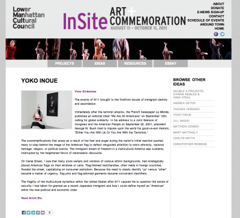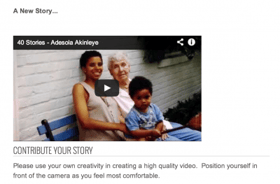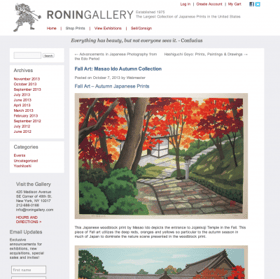
 Arts organizations must extend their brands online to improve fundraising, engage audiences and build advocacy. A media company is a organization that publishes useful, interesting, entertaining or enlightening content in the hopes to attract and build an audience. The reason I say arts organizations should be like them is because arts organizations need to extend their experience beyond their own walls. They need to open up.
Arts organizations must extend their brands online to improve fundraising, engage audiences and build advocacy. A media company is a organization that publishes useful, interesting, entertaining or enlightening content in the hopes to attract and build an audience. The reason I say arts organizations should be like them is because arts organizations need to extend their experience beyond their own walls. They need to open up.
Blogs help with this. Blogs can help organizations by widening their jurisdiction when it comes to content and conversation topics. Blogs allow arts organizations to discuss issues, subjects, events, trends and philosophies that exist on the periphery of their primary offering--their exhibitions, performances, events or happenings. This can make the arts accessible and relevant to new audiences. The content of blogs (when created by arts organizations) can help drive conversations with existing advocates that will reach (new) prospect audiences. The same reasons businesses should blog apply to arts organizations.
According to a report by Hubspot, organizations with 51 to 100 pages generate 48% more traffic than organizations with 1 to 50 pages.
 Why should arts organizations embrace digital marketing?
Why should arts organizations embrace digital marketing?
 Tell stories online
Tell stories online
Use a blog to tell stories that build a deeper, richer relationship with users. The blog format will allow your organization to be less formal in the delivery of content. For example, a blog article can be written by the artistic director or a contributor. This will allow freedom in the types of stories told, as well as the story structure. Consider interviews, behind-the-scenes, contemporary issues, news, events, background or context articles, drawing a relationship between the past and present, etc. The potential subjects are countless.
Media can be viral
Providing access via media can be great for brand and organization engagement. For organizations that are concerned about live streaming events, consider providing videos after a performance online with carefully-placed social sharing tools. This will help extend reach and engagement online, as audience members share and support your organization's content. Additionally, highly shared pages that include videos, photos and other media make for great recruitment vehicles. Ensure that social sharing tools (Facebook Like, Pinterest pins and Twitter sharing) are easily accessible and placed near highly engaging media.
Engagement tools
Set up an RSS feed, connect your blog to Ping-O-matic to auto-alert Google as you post, nurture meaningful commenting and be responsive, add social sharing buttons, recommendation engines and use alerts to make your social media participation more proactive.
Make your blog's content SEO friendly
Build a keyword and SEO strategy. There are plenty of free SEO planning tools available to help you, including Google Webmaster Tools, Google Analytics and Google Adwords opportunities. Don't just focus on broad keywords like "arts in New York." Ensure your keyword strategy includes longtail SEO. Blog titles are key. Make sure your blog titles are SEO friendly and your use keyword header tags.
Recruit online
Ensure that your organization's website offers call-to-actions (CTAs) that are relevant and visible. Remember to experiment with these calls-to-action, both in terms of language and placement on the website. Use tracking and analytics tools to measure the impact of iterative changes to your CTAs. Understand where the best placement for engagement tools are. Remember if you are asking for users' information, make sure they know they will receive something valuable in return. Spell out the value. The value may be opportunities for discounted admission or special content, for example. Some for profit lead generation and conversion techniques could apply to arts organizations--explore these website lead generation techniques using clear calls-to-action.
More content means more sharing opportunities
Content is the key to digital marketing. Content is the life blood of SEO. Google and Bing loves fresh, original content. This same fresh, unique content is a vessel for social media sharing, which can allow supporters push an arts organization's content to Pinterest, Youtube, Vimeo, Facebook, Twitter, Instagram, Reddit, Stumbleupon, etc.
Get inspired
For some, getting started with blogging is the hardest part. Finding inspiration is more difficult in the beginning, but here are a few tips for blog marketing inspiration. Participate in the communities where your audience already gathers. An arts organization doesn't need to spend a dime to figure out where a large portion of their audience can be found on the web.
Publishing schedule
As your organization begins to employ content in a larger way to build visibility, advocacy and brand engagement, a publishing schedule will help keep your team organized and will prevent drop-off. Being consistent is important. Spread out your posts evenly over time. Try to publish on a realistic schedule: daily, weekly, monthly, etc. In order to see begin gains in traffic and engagement, your organization will need to publish frequently. Content is at the heart of search engine optimization.
by Jonathan Franchell, CEO of Ironpaper - For more tips and hacks: Need to remove a new line after h1 tags? Both web designers and SEO practitioners need to employ headline tags: H1, H2, H3 in several ways to improve web page structure and tag...

The Crowded Arena of the IT Marketplace Updated December 2024 The Information Technology (IT) landscape is experiencing rapid growth and intensifying competition. IT spending is projected to reach nearly 5.1 trillion U.S. dollars in 2024, a...

Updated December, 2024 The field of digital marketing is evolving rapidly in response to new technology and changing buyer expectations. To help career-minded marketers, we’ve rounded up the top 10 skills needed to succeed in the field. These are...

The marketing industry is transforming significantly due to generative AI and increasing market complexity. Gartner's prediction of a 25% decline in traditional search traffic suggests that the era of search engines is dying. AI tools, particularly...
